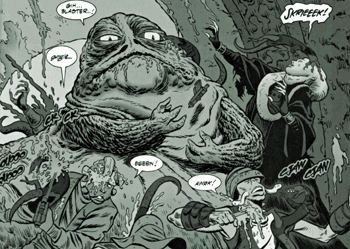Slug Fest
Jabba the Hutt slimes his way through a new graphic novel
A WITTY TITLE, an idiosyncratic artist and a lovable main character--the combination promises good things for Jim Woodring's Star Wars: Jabba the Hutt--The Art of the Deal (Dark Horse Comics, $9.95). Unfortunately, this graphic novel about the most interesting alien in the Star Wars movies is a little disappointing.
The Art of the Deal is a series of four tales (published separately in 1994 and '95), rather than one long story. The collection lacks the strong theme that any kind of novel--even a graphic one--needs. Even more disappointing is the fact that writer Woodring didn't do the artwork himself.
Woodring is the bizarre talent responsible for Frank comics (available in various collections by Fantagraphics Press). He's the closest modern-day artist to George Herriman, the one-of-a-kind talent who created Krazy Kat. Woodring's antihero, Frank the Cat, is a bloodier, stranger figure than Krazy. Frank prowls a candy-colored landscape alive with small, carnivorous creatures. A lumpy, pathetic monster called the Manpig is Frank's companion and dupe. The sharply drawn images are menacing, inexplicable, often grisly.
In The Art of the Deal, Woodring is working with a character so famous that it's probably a waste of ink to describe him. Jabba the Hutt is based on a little bit of obscure local fauna: the banana slug of the Pacific coast. (Many do not realize that the slug can descend from a branch on a thread of its own slime, like a spider; they're bad enough under your shoes, but they're even worse over your hat.)
Weighing in at several tons, this drooling, amber-eyed, Buick-sized mollusk glides around on a flying dish. He's the Sydney Greenstreet of the Star Wars trilogy. Jabba is an interstellar fence, a slave trader and a munitions dealer--and like all of the villains in the series, the object of lively cult interest.
Jabba is popular enough to rate a cameo in the recently revised first Star Wars film. Unfortunately, the computer animation failed to capture the essence of the character, and he looked sort of ineffectual and down in the mouth.)
His big scene comes in The Empire Strikes Back, when Jabba (played by a huge and remarkable puppet) is throttled by Carrie Fisher's Princess Leia as punishment for dressing her in a degradingly tiny outfit. Thanks to Jabba's talents as a fashion couturier, millions of 13-year-old boys suddenly realized that there was more to life than trading Star Wars collectibles.
The four adventures in The Art of the Deal track Jabba on a long business trip. The title story (the best in the book) finds him in a complex series of transactions with the "gaar" (or ruler) of a planet. The welcoming ceremonies for the Hutt, including an interstellar pit bull match, turn ugly fast. Surviving this debacle, Jabba falls victim to "The Hunger of Princess Nampi." Nampi is an 18-wheeler-size slug looking for a husband; the story is gross and slightly misogynistic--an interstellar fat-lady joke.
In "The Dynasty Trap," Jabba flies to Smarteel, a planet run by a feuding royal family, and ends up like Toshiro Mifune's character in Yojimbo, having to take all sides in the rivalry. Lastly, in "Betrayal," Bib Fortuna, Jabba's filed-toothed, tumor-headed majordomo, hatches a plot against his obese boss, but his timing is bad. Another enemy takes the same moment to strike, using kill-trained "freckers": dog-sized talking weasels.
FOUR DIFFERENT inkers worked on the collection, which is the reason for the varied look. The crediting of the artists is sketchy; apparently Pamela Rambo did the inking on "Betrayal," the best-looking story in the book.
In The Art of the Deal, Woodring faces the opposite of the cartoonist's usual task. For a Star Wars comic, it is necessary to change a two-dimensional caricature into a character. And Woodring doesn't pull off the difficult transition.
The title of this graphic novel, a sly reference to Donald Trump's memoirs, suggests that an inner view of Jabba the Hutt will be revealed, instead of just a history of his acquisitions. There's plenty of gore and alien guts for the kids, but the buried side of Jabba would have been far more interesting. What exactly is the planet of the Hutts like? How legal is Jabba? Where exactly does he fit into the brutal but inefficient Empire? And what makes Jabba the Hutt run? (Or slither.)
Backstory, damn it! Jabba is the one character in all of the Star Wars series I want to know more about instead of less. Proposed future adventure: Worn out by the pursuit of wealth, Jabba develops his soul. The Force is such a vague religion that there's room even for his sort, and more repellent figures than Jabba the Hutt have made a killing in the spirituality racket.
[ San Jose | Metroactive Central | Archives ]
![]()

Singing the Ooze: Life is tough when you're a Buick-sized slug with enemies chasing you from one end of the galaxy to the other.
From the August 6-13, 1998 issue of Metro.
![[Metroactive Books]](/books/gifs/books468.gif)